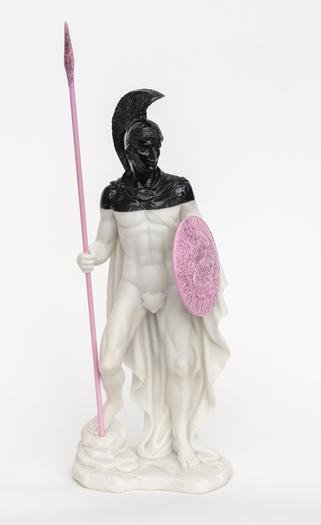Wafaa Bilal
dal 4/3/2015 al 13/3/2015
Segnalato da
4/3/2015
Wafaa Bilal
Driscoll Babcock Galleries, New York
Lovely Pink. An installation of 12 unique sculptures which, in the wake of ISIS's destruction of Iraqi cultural heritage, resonates with the destabilization of iconic structures.

Driscoll Babcock Galleries presents Wafaa Bilal: Lovely Pink, an installation of 12 unique sculptures which, in the wake of ISIS’s destruction of Iraqi cultural heritage, resonates with the destabilization of iconic structures. In Lovely Pink, Bilal has manipulated miniature reproductions of twelve of the most recognizable sculptures in Western history—including Michelangelo’s David, The Venus de Milo and The Winged Victory of Samothrace. The mass produced tourist objects, made of cold cast resin and bonded marble, are covered with heavy black enamel and heated industrial shrink wrap, creating a veil that obscures faces, appendages and bodies in whole. Shining with the slickness of the petroleum-based enamel paint, the figures drip with black – like so many causalities of an offshore oil spill. While creating these new works of art, Bilal must in essence destroy the original cultural artifacts. This act of destruction carries with it the weight of mirroring the actual and horrific destruction of Iraq’s cultural heritage sites (including the Shia Saad bin Aqeel Husseiniya shrine in Tal Afar and Mosul’s al-Qubba Husseiniya mosque) by the militant group ISIS.
In Ares, God of War, Ares’s spear and shield are covered under a layer of “Lovely Pink” glitter nail polish that contrasts sharply with the sculpture’s representation of classical, idealized hyper-masculinity. At this miniature scale, Ares’s weapons are rendered comical and impotent, evoking children’s toys. In contrast, Perseus Beheading Medusa is dipped entirely in funerary black as Perseus stands victorious, rising above a beheaded female form and holding high a blurred and featureless head distorted by Bilal’s shrink wrap shell. Here, weapons are lethal, their victim obliterated both in body and in name, standing in for the innumerable nameless fallen.
In Winged Victory of Samothrace, the goddess Nike is similarly drenched in the glossy black enamel. The canon of art history has immortalized the Greek sculpture as a masterpiece of the ancient Western world and Nike as a messenger of victory. Yet Bilal engages her here as a recipient of violence, her wings bound and draped in a heavy oiled coat. Calling new attention to her decapitated, dismembered body—to her physical inability to sound the call of victory—dispels the possibility of triumph through warfare.
Wafaa Bilal has been represented by Driscoll Babcock Galleries since 2013.
Bilal’s work is represented in major public collections, including Mathaf: Arab Museum of Modern Art, Qatar; Museum of Contemporary Photography, Chicago; Milwaukee Art Museum; and the Los Angeles County Museum of Art, California. He has exhibited extensively in galleries and institutions throughout the world, including the US, Thailand, Iraq, the UK, Dubai, Lebanon, France, and Germany, and he has served on the panels of over twenty major global universities and institutions, including the Tate Modern, UK; Harvard University; Stanford University; Museum of Art and Design; the Global Art Forum, Qatar; and the Inter-Society forthe Electronic Arts, Turkey. His work has been reviewed in major publications, includingARTnews Art in America, The New York Times, The Wall Street Journal, and Newsweek, and he is the author of the criticall-acclaimed 2008 publication Shoot an Iraqi: Arts, Life and Resistance Under the Gun.
Image: Lovely Pink, Ares, god of war, 2014. Cold cast resin, enamel paint, shrink-wrap, fabric, latex, and crude oil 12 1/2 x 6 x 5 1/2 inches
For additional information and images, please contact Tess Schwab, Director tschwab@driscollbabcock.com
Opening Reception: Thursday, March 5, 6-9PM
Driscoll Babcock Galleries
525 West 25th Street New York, NY 10001
Tuesday–Friday: 10:00am–6:00pm, Saturday: 12:00pm–6:00pm



